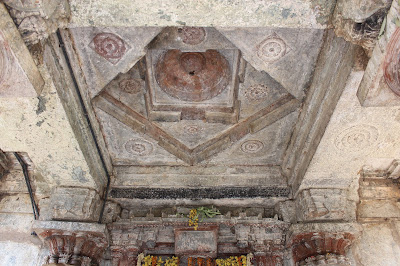Bhairavas Gaurding in the dark- a temple by the lake
In
the NorthEast (Ishanya) corner of Turuvekere, KA less than 100 Kms east of
Halebeedu, the grand capital of Hoysala is the 750 years old Mula
Shankareshvara temple, built around 1260 under the auspices of the Jain Hoysala
king, Narasimha III.
In
local parlance , it is called MooleShankara and it seems a logical name given
that it is situated in a corner of the town ( Moole = corner ) . But the actual
name is Moola Shankara , a name that records the fact that it was the first
temple built in the town which came up on the lands granted as Agrahara ( Tax
Free Holdings) to learned brahmins during the reign of the Hoysala, Narasimha
whose wife Lokambike came from this region. The original name of the Agrahara
town was "Sri Sarvajna Vijaya Narasimhapura"
Mula
Shankareshwara is a beautiful temple , maintained by the department of
archaeology. The base mouldings of the outer walls carry the signature of the
main architect- Janaka Achari
The temple reminded us of the one dug out at Talekadu.The temple ,
situated at a level lower to the present ground level , was , according to the
priest , dug out , much like the Talakkadu ones .
The reason why it it lay
buried turned out to be a tale, both sad and heartwarming by turns . It turns
out that sometime in the past, for whatever reason, the temple was filled up
with hay and burnt by unnamed arsonists. Though the sturdy beams split, the
building did not collapse. After the misfortune, the humble locals, who wanted
to salvage their shrine, packed four feet of earth all around to keep it from
falling. It dint fall, but dint live either. Soon vegetation claimed it. In
recent times, again some goodsamaritan locals dug it out and with able and munificent
support from The Dharmasthala Trust, renovated the temple. Dharmasthala's
signature Nandis were added above the cornice, even though they dint blend with
the over all style of the temple . However that may be, the temple lives again,
and that is all that matters.
It looked like a small jewel well cut
and polished consisting of all the standard features of a Hoyasala temple;
Sukhanasi connecting the Mukhamandapa with the garbhagriha, dark mukhamandapa
with no windows, the porch leading to the mukhamandapa consisted of an awning
with two decorative pillars,four lathe pillars supporting the ceiling of the
mukha mandapa….a modest temple, not very embellished yet touching us deeply
with its atmosphere!
The
porch with its half pillars also serves the purpose of an open hall with a
single bay ceiling.
The Mukha mandapa was dark and unlit in the absence of windows
The dark hall became suffused with an ethereal glow , when the priest lit the aarti lamp .
The Nandi facing the Sivalinga became
prominent and so did the other idols in the Mukhamandapa!
The couchant Nandi inside the mukha mandapa, very modest by Hoyasala standards.
The couchant Nandi inside the mukha mandapa, very modest by Hoyasala standards.
Another unique feature of the temple is that , here Shankara is spouseless ! There is no Parvathi either in the Garbhagriha or in a separate niche. Well the mukhamandapa already has the Saptamatrikas, more women power may tilt the balance !
The Saptamatrika panel is unique in that it shows Saraswathi on
one side of the Mothers , while on the other side is the usual Ganesha.
The
East facing Shankareshwara, with a South facing entrance, used to have the sun
shine upon it through a structured small opening on its west wall. On full moon
nights, moon rays reflected by the Kere (Lake) will pass through the same
opening and worship the linga....and serpents even to this day are supposed to
come, dance and offer their worship to the lord.
The
Bhairava idol standing on a pedestal in tribhanga under a floriated prabhavali,
has four hands. Each hand holding a sword, a trident, a damru and a severed
human hand. He is naked but well ornamented. He wears a yajnopavita. The vermillion smeared forehead and torso, protruding teeth, powerful eyes, garland
with red flowers all these give him frightening appearance.
The damaged but magnificent idol on the left of the sanctum was so beautiful that associating it with Bhairava was the farthest from our minds. But the priest kindly educated us by bringing the lamp closer for us to discover his two fangs as definitive id ! Kapala Bhairava , he was , but unfortunately missing hands .
The structures around the temple, today, have
cut off the lights of the sun and the moon and bereft of modern lights in the
interior, the temple now is cared for and protected by the two Bhairavas; Kala
Bhairava & Kapala Bhairava….the protector!
खड्गं कपालं डमरुं त्रिशूलं हस्तांबुजे सन्दधतं त्रिणेत्रम् ।
दिगम्बरं भस्मविभूषिताङ्ग नमाम्यहं भैरवमिन्दुचूडम् ॥
Maybe that is why we felt as we were in
the benign presence of Bhairava, the one who will guard us and protect us !












No comments:
Post a Comment